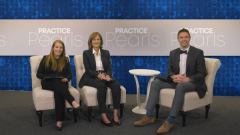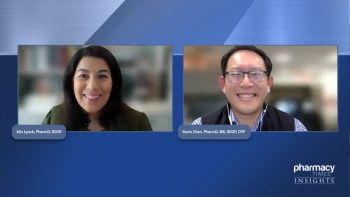
The Impact of Pharmacists in Treatment Pathways of HR+/HER2- Breast Cancer
The panel of experts explore the contribution provided by pharmacists in the treatment landscape of patients with HR-positive, HER2-negative breast cancer.
Episodes in this series

Ryan Haumschild, PharmD, MS, MBA: Let’s explore the treatment landscape a little further for HR [hormone receptor]–positive, HER2 [human epidermal growth factor receptor 2]–negative patients. I want to build on some of the things that Dr Moore has talked about in the past regarding the importance of pharmacists. Tell us a little about the decision-making process. When the team is coming up with their therapeutic selection or treatment plan for a patient, how do you weigh in on that? What’s your influence? When and where are pharmacists involved in the management and selection of the treatment?
Heather N. Moore, PharmD, BCOP, CPP: First and foremost, it’s important that as the drug experts we also have a good understanding of the literature and efficacy of the data. It’s important to know which clinical trials are most relevant and what was seen within those clinical trials from a toxicity standpoint. First, it’s making sure that a treatment is appropriate and aligns, that this is the best treatment for that patient.
Next is—going back to what I mentioned previously—making sure that the drug fits the patient and thinking about whether we need to do dose modifications up front. We’ve seen some data that suggest that age may be a factor in terms of tolerability for some agents. There are some patients for whom you think about a “start low, go slow” approach vs starting at full dose. We think about toxicity management, as Dr Dent mentioned. Are there certain things we need to do up front to optimize therapy to make sure we’re setting this patient up for success? Those are things that go hand in hand. We’re thinking about toxicity management, preventing [toxicities], dose modifications, other therapies the patient may be on, other comorbidities, and how we’re pulling all that in and making sure that this is the best therapy, that they’re prepared for this, and that we’re setting them up for success.
Ryan Haumschild, PharmD, MS, MBA: As a pharmacist, you have a lot of knowledge. It’s important to know not just the guidelines but the abstracts and literature and what’s upcoming. If you don’t mind, let’s talk a little about the treatment landscape for HR+, HER2- patients. What are some common therapies we’d see being used in the first and second lines and potentially as salvage therapy? Could you go into a little detail about the SERDs [selective estrogen receptor downregulators] and SERMs [selective estrogen receptor modulators] we’re seeing, with data coming out around those and how those might impact the treatment landscape as we see more approvals?
Heather N. Moore, PharmD, BCOP, CPP: We’re all very familiar with CDK4/6 inhibitors as our first-line [therapy] based on the overall survival data and tolerability of those agents. We think about those in our first line in combination with fulvestrant or an aromatase inhibitor. In the second line, we’re identifying patients who may have a PIK3CA mutation and may benefit from a PI3 kinase inhibitor. Then we think about other endocrine therapies. There are some evolving data to help us determine whether there’s a benefit in changing the endocrine backbone. Is there benefit in sequential CDKs? Some of that was presented at ASCO [American Society of Clinical Oncology Annual Meeting] in terms ofthe best next option. We’re also thinking about that same pathway into our inhibitor, with everolimus in combination with exemestane being our endocrine therapies that we’d use up front prior to transitioning to oral capecitabine.
Thinking about SERMs and where oral SERDs fit in, we’re already utilizing fulvestrant within the clinic. But from an endocrine resistance standpoint, having SERDs as an option may help us prolong some of that endocrine therapy. The other thing we have to be mindful of is different combinations with CDK4/6 inhibitors. Going back to what Dr Dent mentioned, we’re trying to extend the use of oral endocrine agents prior to having to transition to chemotherapy because they’re tolerated so well and we’ve seen such good efficacy from these therapies, especially thinking about elacestrant. That paper was recently published. Thinking about other oral SERDs coming into the area, how can we fully utilize this prior to having to transition patients to chemotherapy?
Susan Faye Dent, MD, FRCPC, FICQS: I want to build on that. When I’m thinking about treatment of these patients, I’m always thinking about what the next step is going to be. We know that patient is eventually going to progress. A lot of questions have come up since we’ve been using CDK4/6 inhibitors. As Dr Moore alluded to, if you’re using a CDK4/6 inhibitor and you’ve had great success with it in that patient, what do you do when they progress at the first time of progression? Do you switch completely? Do you go to an mTOR inhibitor and exemestane, Aromasin, for instance? Or do you try to get more mileage out of that CDK4/6 inhibitor and switch the endocrine therapy backbone? These questions are being asked in the clinic. That’s why, as the options emerge for us, we’re asking more questions and trying to gain a better understanding of that while keeping in mind that we want to keep people away from chemotherapy and on endocrine-based therapy as long as possible.
The MAINTAIN trial, which was presented at ASCO, will look at that exact question. Can we try a different CDK4/6 inhibitor or change the backbone of the endocrine therapy and get a little more mileage out of that therapy without having to go to the next step entirely? It’s interesting. We’re learning a lot. But as we learn a lot, there are more questions that we don’t know the answers to. These are very practical questions that come up in the clinic every day. How will someone respond after a CDK4/6 inhibitor? We’re learning more. But because we haven’t had it in the clinic that long, people are starting to progress, and we’re faced with that clinical question on an almost daily basis.
Transcript edited for clarity.
Newsletter
Stay informed on drug updates, treatment guidelines, and pharmacy practice trends—subscribe to Pharmacy Times for weekly clinical insights.




